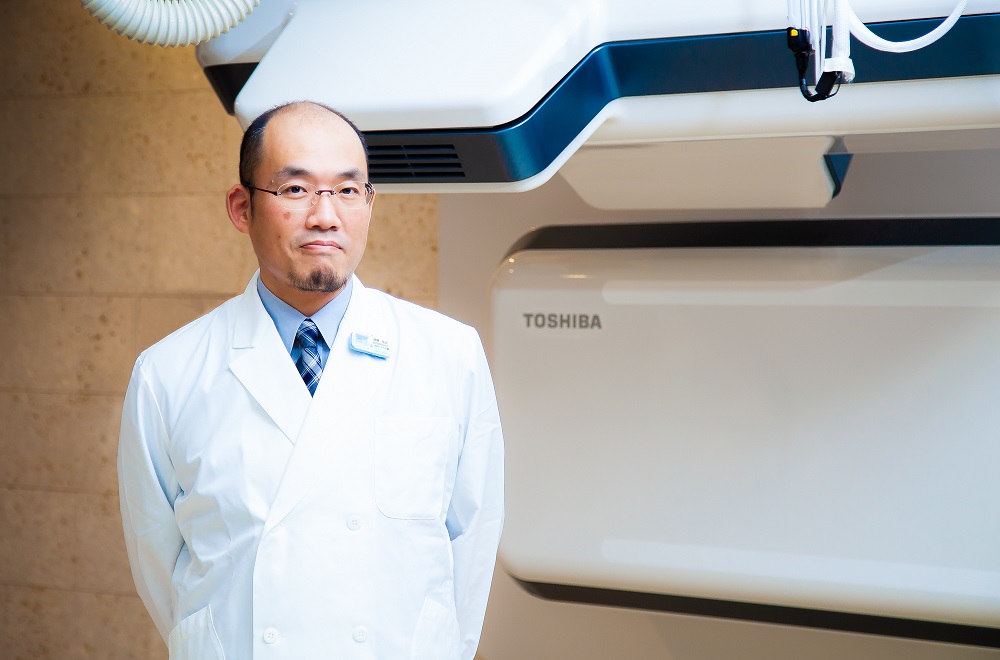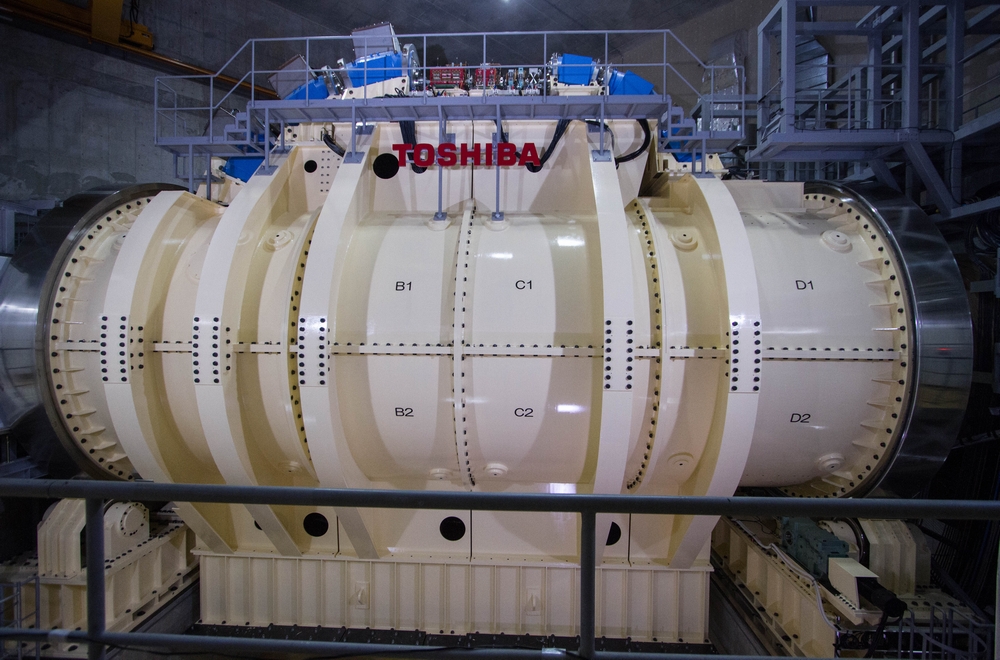In the vanguard of cancer treatment that respects quality of life, Part 2 -Introduction of new heavy ion technology shakes up the medical field
2022/07/13 Toshiba Clip Team
- Imaging software that reduces burdens on radiation therapists and patients.
- Toshiba’s technologies make the Yamagata Model cost efficient and environmentally friendly.
- A determined drive to full-scale operation of rotating gantry.
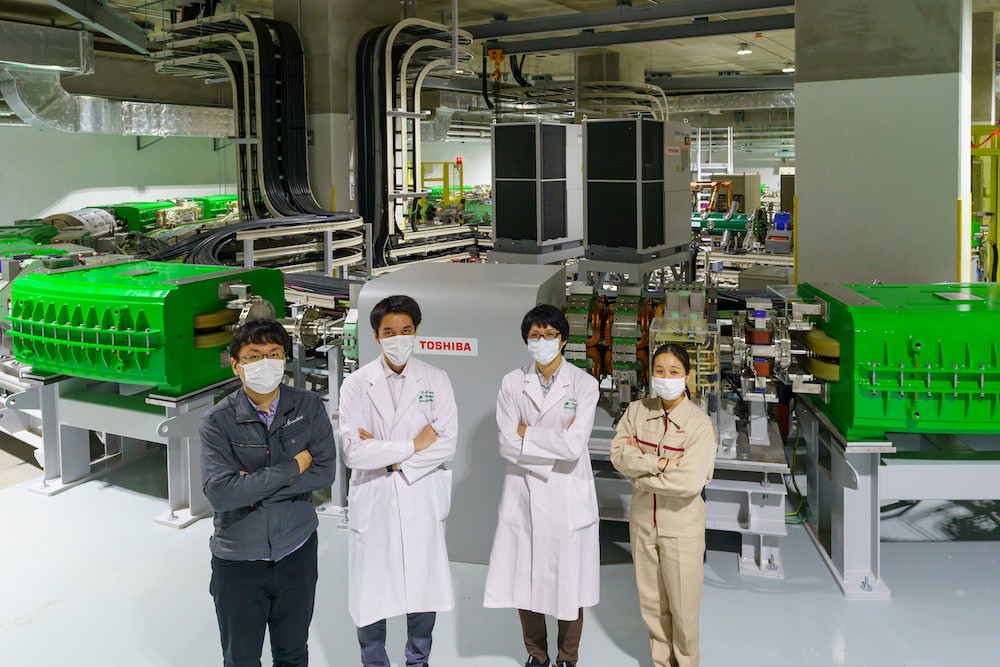
There are only seven units of heavy ion radiotherapy equipment in Japan. They are drawing attention as a new treatment, a paradigm shift in cancer treatment. This treatment was not available in the Tohoku region, Japan’s north east region, until February 2021, when a system was installed in the East Japan Heavy Ion Center at Yamagata University Hospital.
The installation, extremely difficult work, was carried out by professionals from the East Japan Heavy Ion Center, B dot Medical*, and Toshiba Energy Systems & Solutions. Part 1 of this article covered the current state of cancer treatment, an overview of heavy ion radiotherapy equipment, and the installation and adjustment of the hardware in Yamagata. This article looks at software challenges, environmental considerations, and the vision for the future.
*A start-up company originating from the National Institute of Radiological Sciences, with advanced technology and various expertise cultivated there.
Keiko Okaya of Toshiba Energy Systems & Solutions designs and configures software that handles images for positioning patients and monitoring body movement. Before the East Japan Heavy Ion Center, she worked on i-ROCK, a heavy ion radiotherapy facility at the Kanagawa Cancer Center, in Yokohama. She says that a big difference with the Yamagata facility was the direction of taking images used for irradiation treatment.
“In addition to frontal and lateral radiographs of the affected area, i-ROCK also has a treatment room that allows fluoroscopy from oblique angles. At East Japan Heavy Ion Center, radiography and fluoroscopy are done from oblique angles, which reduces the equipment needed. But that doesn’t mean there are no problems,”
The comment draws in Dr. Takayuki Kanai, Assistant Professor at the Tohoku Future Cancer Medical Course, who is responsible for the system to manage irradiation status and patient treatment status, and software for radiation treatment planning. “It was difficult to display images taken from oblique angles in a way that radiation therapists and doctors could understand at a glance. At the treatment stage, before pressing the button to start irradiation, we must confirm the safety of the patient with that image. At first, I felt this was challenging.”
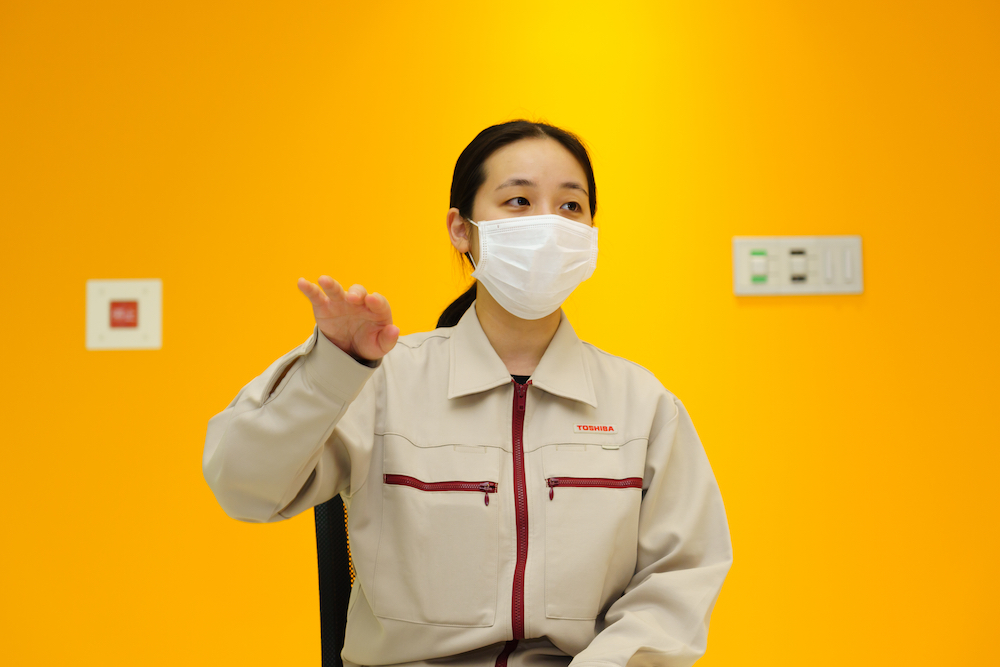
Keiko Okaya, Specialist, First Project Engineering Group, Particle Radiotherapy Business Project Engineering Dept., Power Systems Div., Toshiba Energy Systems & Solutions Corporation
However, the skills of the radiation therapists who deal with images on a daily basis were far beyond what could have been imagined. Within just a month, it is said they were able to adjust, understand, and evaluate the images.
“I’m grateful for the skills of the radiation therapists,” says Okaya. When first considering the display, we assumed that it would be viewed by someone who did not understand it at all, and made every effort to make it intuitive and understandable. For example, a small model of the human body was superimposed on another image. But this didn’t really make sense. An unnecessary display can sometimes be a nuisance. At the end of the day, the skills of the radiation therapists were a big factor.”
There was also one more challenge to overcome. This was coordinating the X-ray equipment and the software. “Coordination with other companies’ equipment, which is different from that at i-ROCK, and the difference in image quality became a major issue,” says Okaya. If image quality of an affected area is reduced, it impacts on the treatment. In order to avoid this, they carried out trial and error testing, running the equipment and adjusting the imaging software.
Coming to grips precise irradiation positioning that does not accept even a millimeter of deviation
One other development Okaya was involved with was improving the precision of the positioning software, which automatically calculates the deviation between the CT reference image taken beforehand and the X-ray images taken in the treatment room. Using this value, an articulated robotic arm with seven joints smoothly and quickly moves the treatment couch and positions the patient.
With conventional heavy ion radiotherapy equipment, radiation therapists used their experience and skills to manually set it up. In Souda’s words, the manual workload was so high that “positioning 20 people a day almost short-circuited my brain.” Toshiba first introduced the positioning software at i-ROCK, then at the East Japan Heavy Ion Center.
“We used an anatomical model to repeatedly check positioning accuracy, and completed the set-up,” says Okaya. “However, during treatment we deal with patients whose bones and internal organs move, unlike the model, so we might have to fine tune the software.” Precise positioning is essential for pin-point accurate beam irradiation. “If the patient is misaligned, we cannot irradiate the site accurately. I am proud of carrying out this modest but very important job.” Of course, Okaya is being modest herself in describing the job as “modest.”
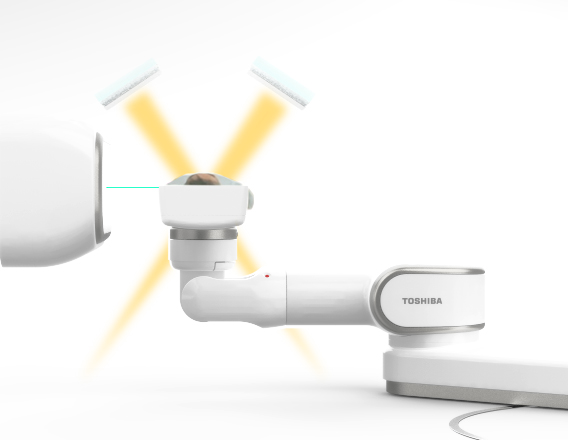
Toshiba’s robotic arm treatment couch
“Positioning is crucial for safe and accurate treatment,” says Kanai. “Misalignment of positioning has the same impact to the irradiated site as misalignment of the beam. Of all the positioning equipment I have seen, this is one of the smoothest and easiest to use in terms of workflow. I think it’s well developed.”
Aware of the extremely high level of precision required, Okaya nonetheless comments with a smile: “The positioning software’s automatic calculation algorithm was developed by Toshiba’s Corporate Research & Development Center. It was made by an all-Toshiba team, and we offer it with confidence.”
To avoid deviation of even 1 mm, it is essential to use respiratory-gated irradiation, so that the beam can reach cancer cells that move as the patient breathes.
“Respiratory-gated irradiation enables treatment that really uses the potential of the rotating gantry,” says Souda, who is responsible for accuracy control and adjustment and safety verification of the system. “We introduced world’s first technology utilizing superconducting magnets used for rotating gantry, and it can move freely through 360 degrees. It provides irradiation from any angle, which means that patients can be placed in a position that does not strain them.”
This is a capability that gives Souda high hopes for the future: “Treatment is currently performed in the fixed field irradiation room and limited to prostate cancers in the pelvic region, which is not much affected by breathing. It’s a relatively simple treatment. We want to accumulate experience with this treatment and eventually expand the range of indications we can treat. We hope to use the rotating gantry to irradiate cancer cells that move with breathing, such as lung cancers.
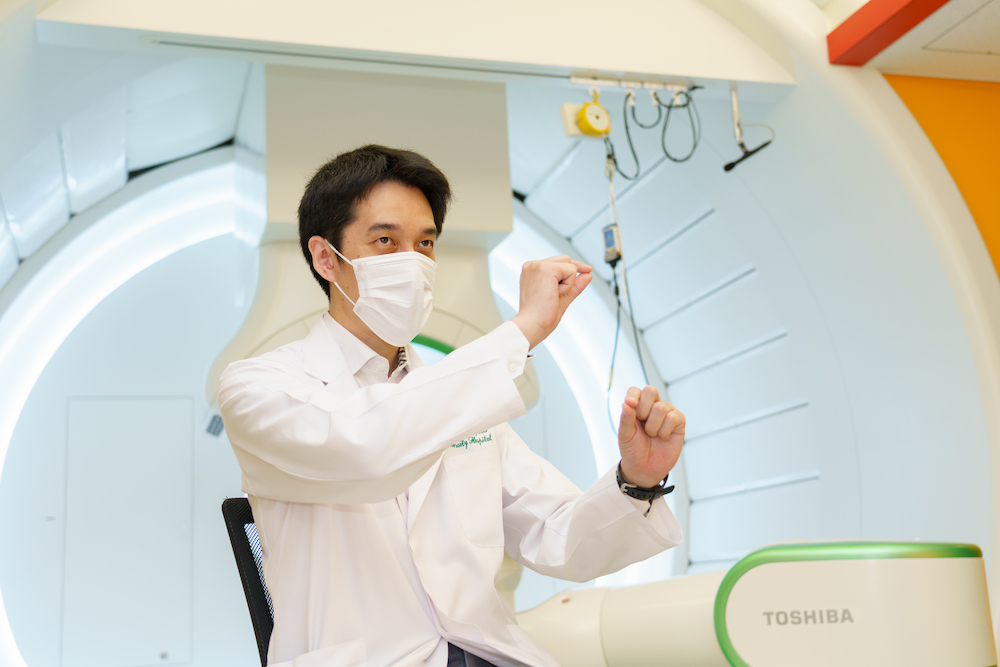
Expressing high hopes about respiratory-gated irradiation with the rotating gantry, Dr. Hikaru Souda, Lecturer, Department of Heavy Particle Medical Science, Graduate School of Medical Science, Yamagata University
Annual electricity bill cut by 20 million yen! Environmentally friendly with labor and cost savings
The system at East Japan Heavy Ion Center shows consideration not only for patients but cost, too. Heavy ion radiotherapy is expensive, and cutting costs is crucial for its progress. To find out how a 20-million yen cut in the electricity bill was secured, we asked Kanai. The secret, he told us, is technology to narrow the gap between magnetic poles.
“Magnetic force bends the beam, and a larger bend requires a stronger magnetic force. Electromagnets are used in heavy ion radiotherapy equipment, and they consume a lot of electricity to realize the strong magnetic force. But if you narrow the space between the magnets, a strong force can be generated with less electricity. This helps save energy and is environmentally friendly, and it also cuts costs.”
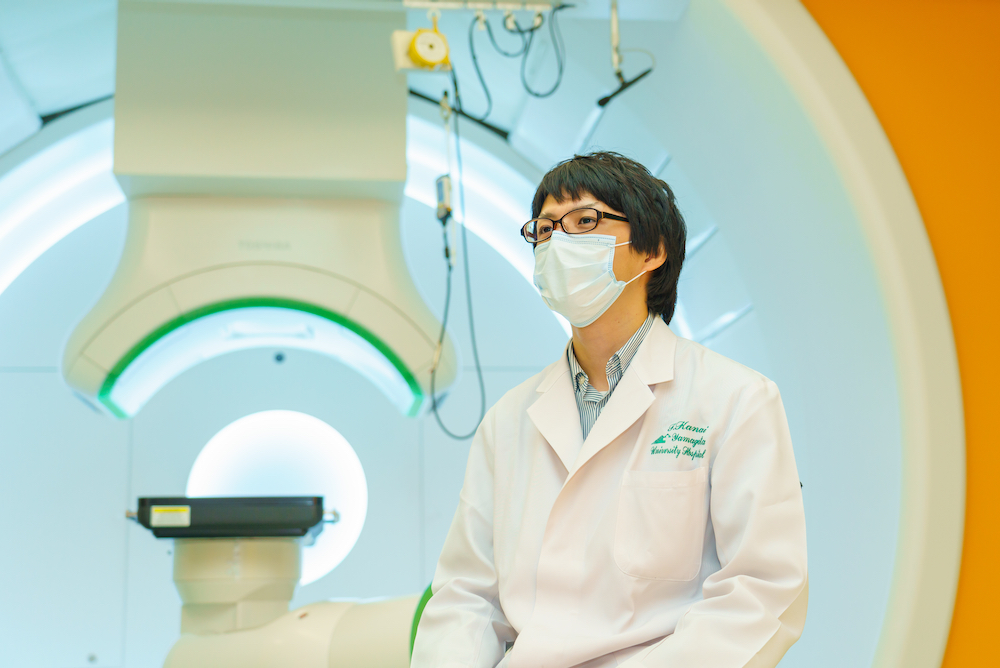
Talking about the meaning of energy and cost savings, Dr. Takayuki Kanai, Assistant Professor
and Medical Physicist, Department of Regional Cancer Network, Faculty of Medicine, Yamagata University
In fact, Yamagata University has conducted basic research into this technology since 2013-14, in collaboration with other companies. Toshiba carried out its own in-house development and has now introduced the technology. However, it was not all plain sailing, and Souda still recalls the struggle.
“We could not use the parameters we had developed with i-ROCK, and we had to redo the beam adjustment. We have halved the electricity used by the accelerator’s electromagnets, but acceleration also slowed by that amount. Cyclic operation that normally took 2-3 seconds started to take about 5 seconds, and when that happened the number of particles circulating in the beam was severely limited. The impact was much greater than we had anticipated.”
Thanks to Toshiba’s in-house development that narrowed the gap between the magnetic poles, the impact from reduced electricity was solved. As a result, they are on track to reduce an electricity of more than 120 million yen for normal equipment to below 100 million yen. This cuts not only costs, but the environmental burden. In addition, the power source has been reduced to half of its normal size, greatly contributing its miniaturization.
Installing the compact, high-spec, energy-saving Yamagata Model. And its future
On February 25, 2021, treatment began at the East Japan Heavy Ion Center, and went smoothly. The Tohoku region had a new cancer treatment option. The number of patient reservations is already three times more than expected.
At the time, as the start of treatment drew closer, Saraya started to feel downhearted about meeting the deadline. They managed to make it by steadily reducing beam fluctuations and making corrections while measuring deviations of 0.5 mm. One factor that helped in this was the smooth operation of the treatment planning system, which visualizes the radiation dose to be delivered to the body and creates irradiation plans based on calculations of the dose distribution in and around the affected area.
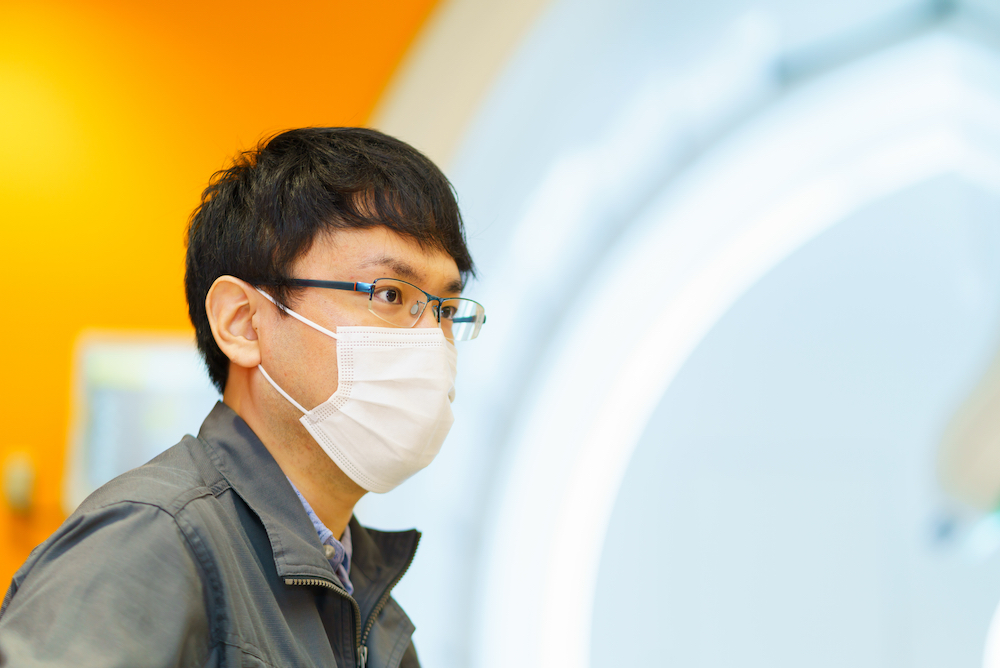
“In the future, it is important to make modifications at a reduced cost and incorporate user opinions.” says Yuichi Saraya, Ph.D., Section Head, Engineering Sec., R& D Department, B dot Medical Inc.
Deeply aware of the scheduled treatment start dates for patients, Souda and Kanai continued work with clenched teeth, thinking, “We must adhere to the February 25 treatment start date at all costs.” They shared Saraya and Okaya’s determination made sure that the treatment was able to start without hitch. But achieving that was, literally only the start, as only horizontal fixed field irradiation started operation. The immediate goal is to get the rotating gantry into full and stable operation.
“The equipment lineup of the East Japan Heavy Ion Center will be complete only when the rotating gantry is working stably,” says Souda. “I want to ask Toshiba and B dot Medical for one final push to help us out.” Kanai agrees: “The current positioning system is near completion. Stable operation of the rotating gantry is just a matter of time.”
At this point, they are looking further into the future. “One of Toshiba’s strengths is precision positioning,” says Souda. “I think how to advance it further will be a major theme. For example, being able to do three-dimensional positioning would take it up a level. As a joint research project, I would like Toshiba and Yamagata University to exchange opinions and come up with ideas,” stating his expectations.
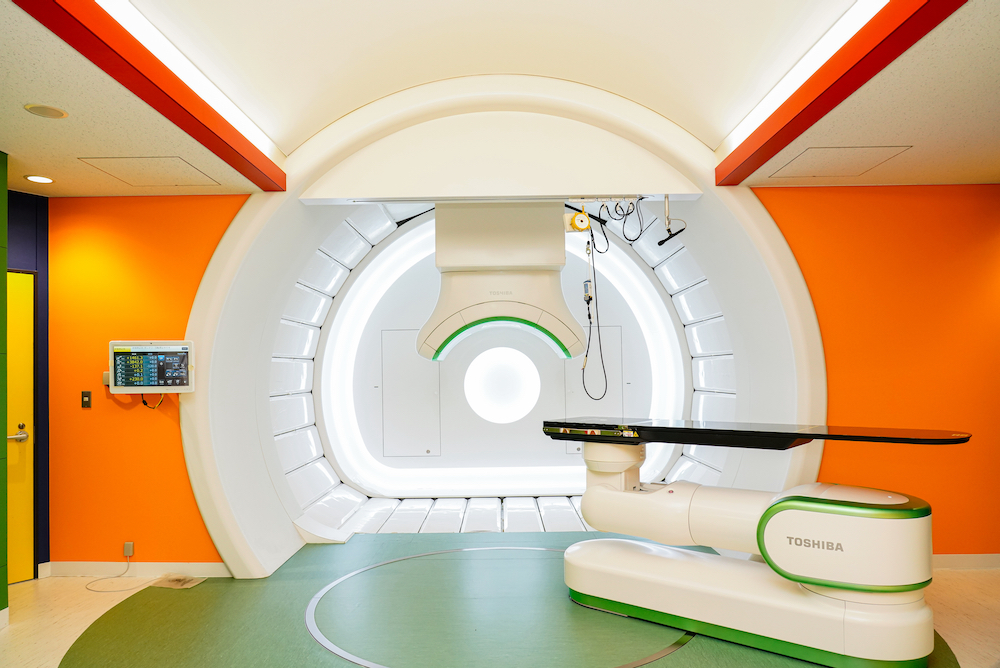
Further refinement to improve positioning precision
Okaya responded: “X-ray and CT scanning from an oblique angle has been achieved at the East Japan Heavy Ion Center. The next challenge is using other images. I recognize it as a new area for development.” Saraya also thinks that “it is important to incorporate the opinions of users, such as patients, doctors, and radiologists, while upgrading the system.”
In 2012, when the forerunner of this project, the Yamagata University Heavy Ion Cancer Therapy Facility Preparation Office, was established, there was not a single person at Yamagata University with experience in heavy ion radiotherapy. “That was the biggest issue, and it was a challenge. But despite that, we managed to start treatment. You could say that we proved that it is possible to install the equipment at a facility that doesn’t have experienced staff. This might be the biggest success we achieved in Yamagata,” says Kanai.
The East Japan Heavy Ion Center’s heavy ion radiotherapy equipment has advanced to a new treatment paradigm that improves quality of life for patients through the combined efforts of three parties. The equipment can be installed in a smaller space and consumes less energy than other systems, yet it has high-level specifications and is easy to use for doctors and inspection engineers. The radiotherapy equipment that has made this possible has been welcomed as the “Yamagata Model.” Expectations are high for its further take-up, and global expansion is being considered. Although some have pointed out the difficulty of popularizing the technology due to its advanced system and installation area, the Yamagata Model may be the first step toward making heavy ion cancer therapy a more widespread medical treatment.
* Note: Departments and titles are as at the time of interviews.
![]()
Related Links
*This section contains links to websites operated by companies and organizations other than Toshiba Corporation.
Heavy Ion Therapy | Toshiba Energy Systems & Solutions
https://bdotmed.co.jp/en/





